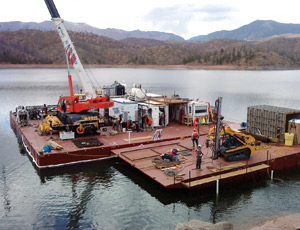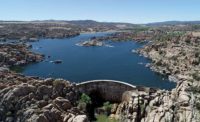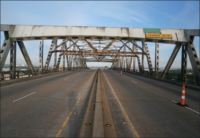Denver Water is halfway through an $18.3-million modernization of the city's Cheesman Dam, with the underwater portion of the project complete and bidding for the second phase under way.

The two-year job, which began last spring with construction of a 1,200-sq-ft control building on the crest, is the 105-year-old dam's first major rehabilitation. The main goal is to upgrade the original outlet works system with new hydraulic valves and pumps that provide more reliable upstream control over water levels.
Work also includes the decommissioning of original valves and installation of new trash racks to prevent debris from entering the intake system.
Located on the South Platte River about 60 miles southwest of Denver, the 221-ft-tall, granite-block structure, which has a 1,050-ft-long crest, allows for storage of 79,000 acre ft of water. It provides nearly half of all potable water to the metropolitan area.
Denver Water did not want to jeopardize that valuable water supply, so it chose to design the project using underwater construction methods to prevent drawing down the reservoir.
Almost a decade of planning and preparation went into the project, with most of the design work done by Denver Water's own civil, mechanical and electrical engineers. Instead of carrying out costly underwater surveys, Denver Water pieced together construction drawings of the dam and budgeted for the unexpected.
Sonar studies and information gained when the 2002 drought exposed portions of the dam provided a good starting point, but most of the details were compiled from the original hand-drawn blueprints, century-old construction photographs and an 1895 field survey of the tunnels.
Saturation Diving
In phase one, managed by Global Diving & Salvage Inc., Seattle, the three internal gate valves were replaced with new hydraulic valves on the dam's upstream face. Each valve was at a different depth, connected to outlet tunnels mined through a rock abutment.
Crews assembled an 80- by 80-ft barge to support dive operations, which began in April 2010 with three months of surface diving on the upper “auxiliary” level. Work on the middle and lower levels began in mid-July, with crews working 24 hours a day, seven days a week through early November.
The depths of those levels, 152 ft and 197 ft, required a complex saturation diving system to allow divers to work for long periods of time. During the 108-day operation, four-person dive teams worked in 12-hour shifts. Two divers worked underwater from a dive bell lowered from a barge on the surface, while two more divers rested and lived inside a decompression chamber on the barge for 28-day periods. During those periods, the chamber maintained the same pressure on the barge that the divers were subjected to underwater.
Hoses running from the barge supplied the dive bell with an air mixture, communications and power.
The airtight saturation system allowed divers to transfer from the dive bell to the compression chamber without the need to decompress to surface pressure.
While underwater, the two divers rotated in and out of the dive bell. At depth, divers relied on a helium and oxygen mixture. One diver remained inside the bell while the other worked alone in the dimly lit water—drilling, blasting, welding, grouting and anchoring pieces into the rock.
Helmet-mounted video cameras fed live video to monitors on the barge, where project engineers determined how to proceed.
“The risk of change orders was immense, and we knew that going in,” says Jeff Martin, the Denver Water dam-safety engineer in charge of project design. “To streamline the process, we negotiated a time and materials rate with Global Diving & Salvage prior to construction. This eliminated delays and budget surprises and allowed everyone to focus on the task at hand in the moment.”
Article toolbar


Post a comment to this article
Report Abusive Comment